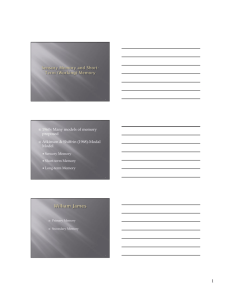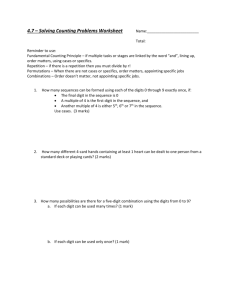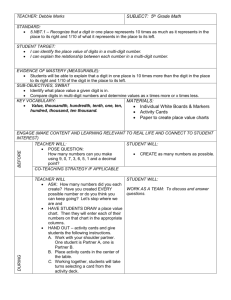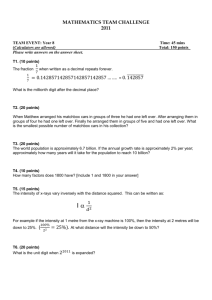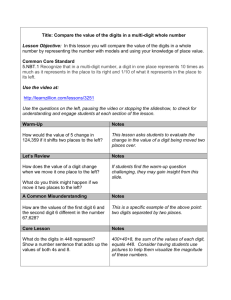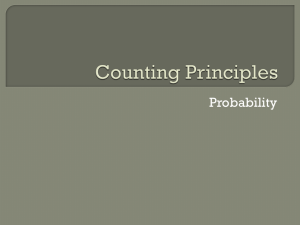Sensory & Short-Term (or Working) Memory
advertisement
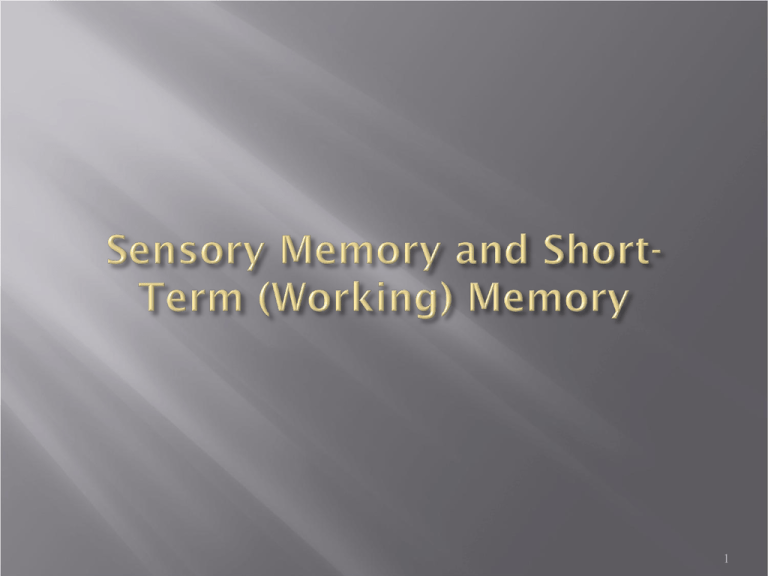
1 1960s Many models of memory proposed Atkinson & Shiffrin (1968)-Modal Model Sensory Memory Short-term Memory Long-term Memory 2 Primary Memory Secondary Memory 3 4 Sensory Memory Short-Term Memory Long-Term Memory 5 6 7 Serial Position Effect Recency Effect Kintsch & Buschke (1969) Behavioral Neuroscience Evidence 8 9 Primacy Effect Recency Effect 10 11 How could we test the idea that the last few items are in STS? How can we test that the primacy effect represents LTS? 12 13 14 H.M. - Epileptic - Temporal Lobes / Hippocampus - STM ---> LTM disrupted K.F. - Damage to Left Cerebral Cortex - LTM Normal - STM capacity severely limited 15 The dog bit the man and the man died. vs. The man the dog bit died. 16 More recent research challenges the strict coding distinction Recency Effect challenged Neuroscience evidence 17 18 19 20 21 22 Sensory memory or sensory register Visual, auditory, touch, taste, smell Relatively raw, unprocessed form 23 Stimuli change Maintain for selection and further processing Integrate fragments of a stimuli into a single unitary perception 24 Sperling (1960) Averbach & Sperling (1961) 25 26 27 * 28 J Z G B S X P L R M Q F 29 30 31 * 32 Y Q C H N D R J V B K S 33 34 35 36 37 1. Location 2. Usefulness 3. Saccades 4. Nature of the code 38 1 K 5 L H J 3 B 7 D 8 T 39 40 41 Neisser (1967) - Echoic memory and the echo Darwin, Turvey, & Crowder (1972) Differences from iconic memory Crowder (1982) 42 43 44 45 46 Nature of Forgetting Duration Nature of Code Capacity 47 Brown/Peterson & Peterson (1959) Trigram task KH R 0 – 18 se c on ds D elay / D istr ac tor (94 7, 94 6, 94 5 . . . 93 9) R ec al l T rigra m 48 K X J P L G S Y T H Z R 49 50 Conrad (1964) Visual display of letters Phonological confusions: (‘D’ for ‘E’ but not ‘F’ for ‘E’) Wickelgren (1965) 51 K Z L F d is trac to r tas k s (c opy down 4 ne w le tte rs) C B G D X M I W re ca ll or ig ina l 4 lett er s 52 Sensory Memory Short-Term Memory Long-Term Memory 53 Limited Capacity (7 + 2) Digit Span Task Difficulties 54 Chunking Recoding:(1 4 9 2 ----> ‘1492’ Columbus) Chase & Ericsson (1982) 55 56 Initial Session (8 digits): Digit Series: 1, 0, 5, 3, 1, 8, 7, 4 SF’s Recall: 105 31874 Later Session (11 digits): Digit Series: 90756629867 SF’s Recall: 907 566 29867 SF’s Report: 9:07 a 2-mile time Still Later Sessions (22 digits): Digit Series: 4131778406034948709462 SF’s Recall: 413.1 / 77.84 / 0603 494 / 870 / 946.2 SF’s Report: 4:13.1 mile time 06:03 mile time 9:46.2 2-mile time 57 58 Decay vs. Interference Waugh & Norman (1965) - Probe digit task Varying the type of distractor task and stimulus material Keppel & Underwood (1962) PI = Proactive Interference Wickens et. al. - Release from PI 59 16 digits -----> probe digit 519635142867394 9837571493862752 60 61 Tr ia l 1 – ‘H JX’ Tr ia l 2 – ‘RL B ’ Tr ia l 3 – ‘ZN F ’ C ont rol ‘ G ST ’ Expe ri m ental ‘493 ’ 62 63 64 65 Revision of STM 3 part system Baddeley Dual task paradigm 66 67 Figure 4.5 with caption 68 AB ‘A’ precedes ‘B’? T or F ‘B’ is preceded by ‘A’ . T or F ‘B’ does not precede ‘A’. T or F 69 E xp e rim e nt 1 : 0, 1, 2 it ems pre lo a ded re ason ing task lett er rec al l E xp e rim e nt 2 : 0 or 6 it ems re ason ing task lett er rec al l 70 71 72 Condition 1 1. Study 6 pictures Condition 2 1. Study 6 pictures while saying “la, la, la . . .” 2. Create mental image, subtract a specific part, and name it. 2. Create mental image, subtract a specific part and name it. ? Fish Result? 3. Number of correct items: 2.7 3. Number of correct items: 3.8 73 Read the following words. When you have finished look away and try to remember them: England, Burma, Greece, Spain, Iceland, Malta, Laos Again read the words, look away and try to remember them: Czechoslovakia, Switzerland, Nicaragua, Afghanistan, Venezuela, Philippines, Madagascar 74 75 76 D ifficu lt to E sti m at e D iffer ent me an ing s ( st orag e capac it y v s. pro cessi ng cap acit y) D igit Sp an Ta sk Mi lle r – “Th e M ag ical N umb er S ev en, P lu s o r M inu s T w o . . .” 7±2 77
